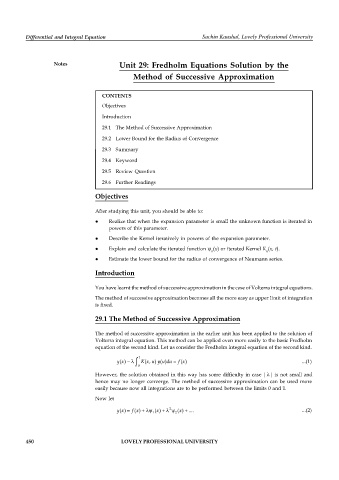Page 457 - DMTH504_DIFFERENTIAL_AND_INTEGRAL_EQUATION
P. 457
Differential and Integral Equation Sachin Kaushal, Lovely Professional University
Notes Unit 29: Fredholm Equations Solution by the
Method of Successive Approximation
CONTENTS
Objectives
Introduction
29.1 The Method of Successive Approximation
29.2 Lower Bound for the Radius of Convergence
29.3 Summary
29.4 Keyword
29.5 Review Question
29.6 Further Readings
Objectives
After studying this unit, you should be able to:
Realize that when the expansion parameter is small the unknown function is iterated in
powers of this parameter.
Describe the Kernel iteratively in powers of the expansion parameter.
Explain and calculate the iterated function (x) or iterated Kernel K (x, t).
n n
Estimate the lower bound for the radius of convergence of Neumann series.
Introduction
You have learnt the method of successive approximation in the case of Volterra integral equations.
The method of successive approximation becomes all the more easy as upper limit of integration
is fixed.
29.1 The Method of Successive Approximation
The method of successive approximation in the earlier unit has been applied to the solution of
Volterra integral equation. This method can be applied even more easily to the basic Fredholm
equation of the second kind. Let us consider the Fredholm integral equation of the second kind.
1
y
x
u
x
u
y ( ) K ( , ) ( )du f ( ) ...(1)
x
0
However, the solution obtained in this way has some difficulty in case | | is not small and
hence may no longer converge. The method of successive approximation can be used more
easily because now all integrations are to be performed between the limits 0 and 1.
Now let
x
y ( ) f ( ) 1 ( ) 2 2 ( ) .... ...(2)
x
x
x
450 LOVELY PROFESSIONAL UNIVERSITY

